Giochi dell'Oca e di percorso
(by Luigi Ciompi & Adrian Seville)
(by Luigi Ciompi & Adrian Seville)

|
Giochi dell'Oca e di percorso
(by Luigi Ciompi & Adrian Seville) |

|
 |

Torna alla ricerca giochi (back to game search) |
 |
| Royall (The) &Most Pleasant Game of y Goose | ||
| “Sold at the Black Lyon in Exeter Exchange in the Strand London. Where you may have Musick Prick’d.” | ||
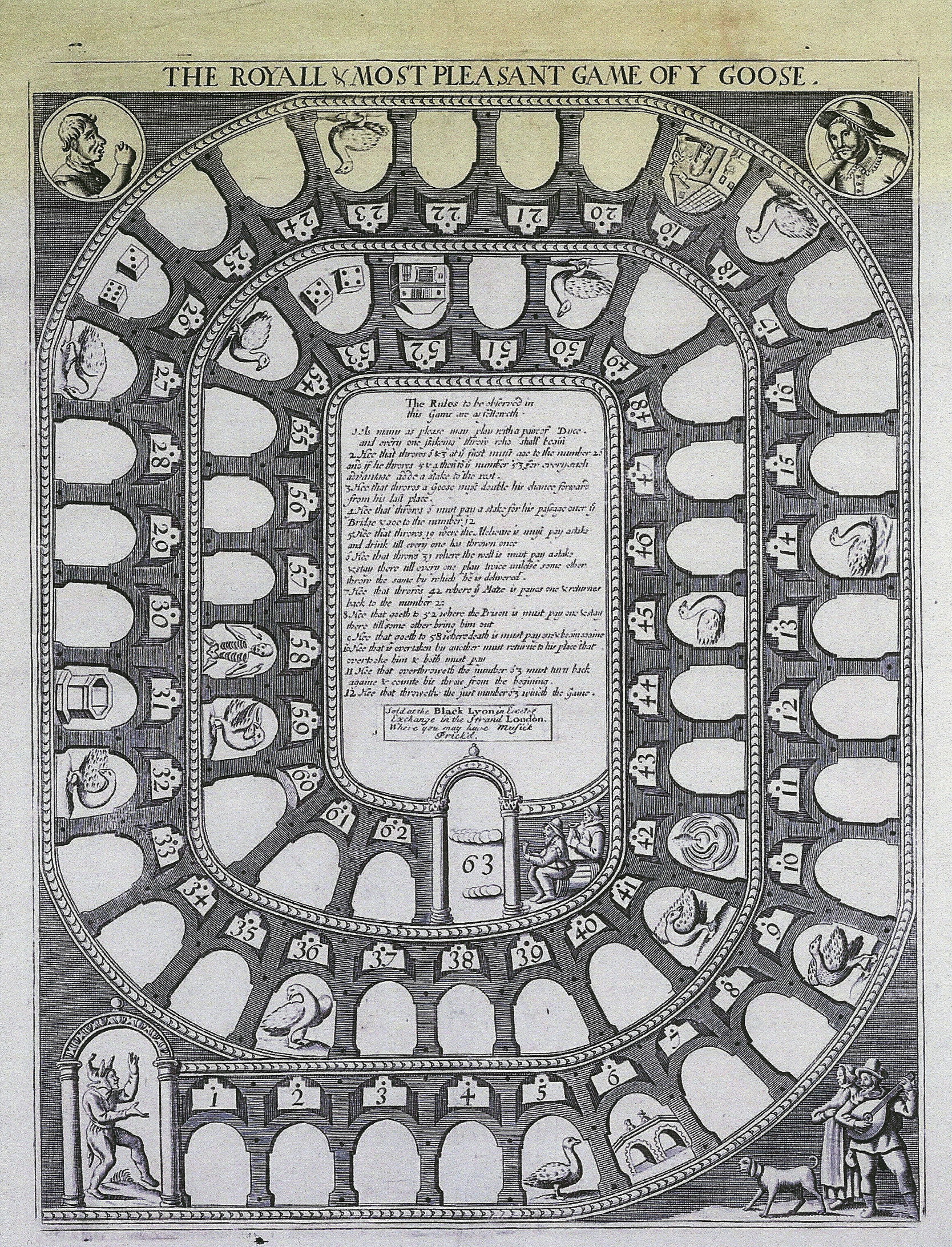 |
Versione stampabile
 |
Invia una segnalazione

|
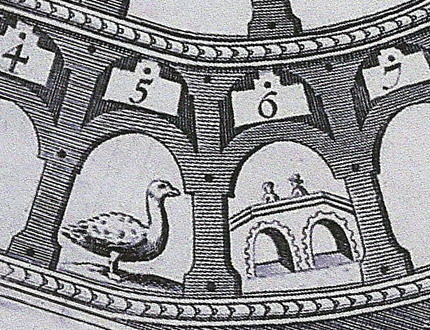 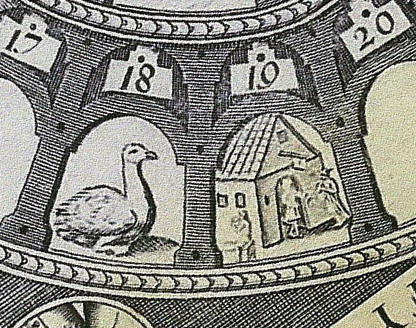 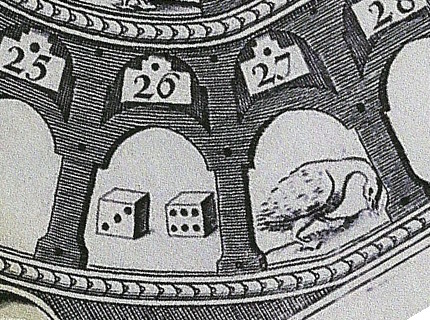 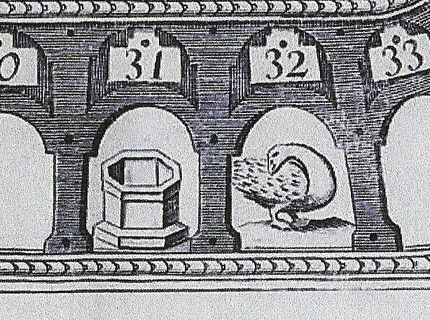 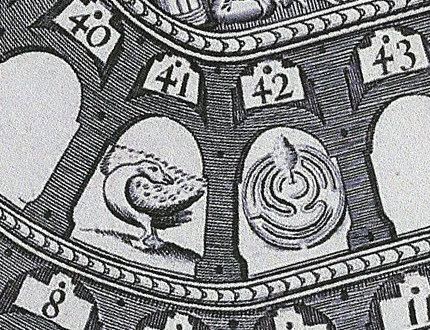 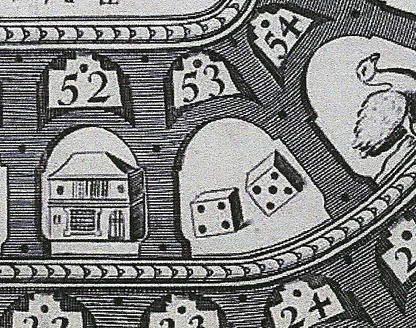  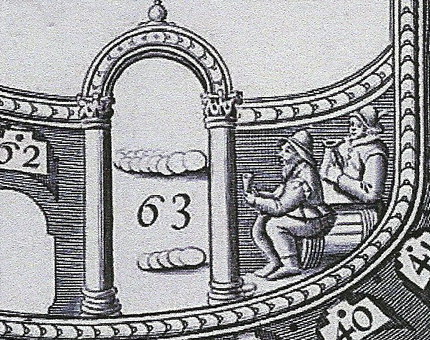 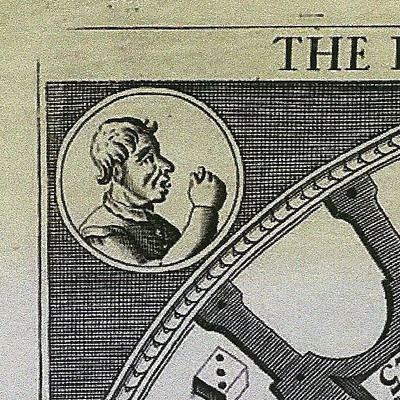 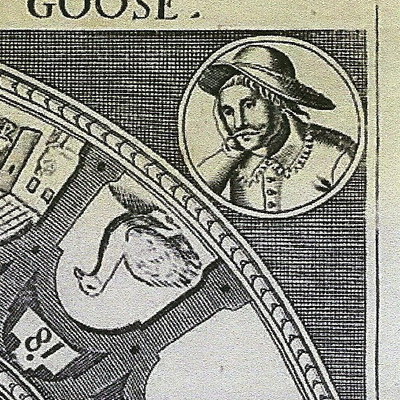 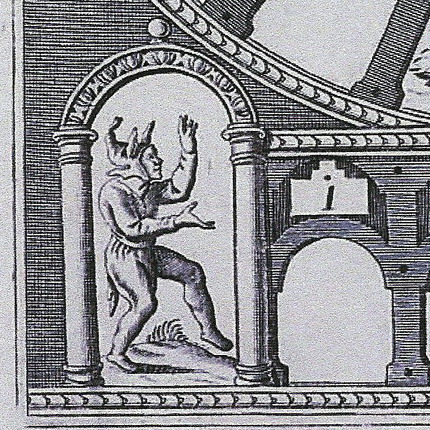 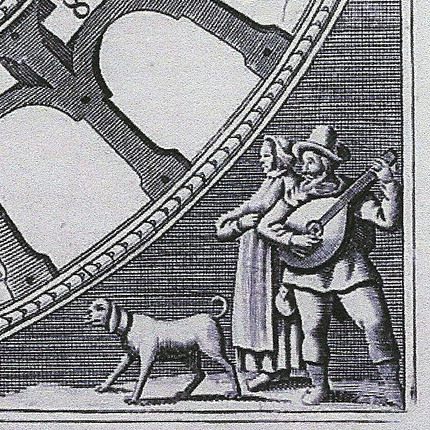  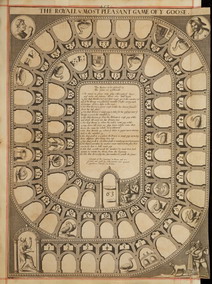 |
primo autore: | Invented at the Consistory in Rome |
| secondo autore: | Overton John | |
| anno: | 1690 | |
| luogo: |
Inghilterra-Londra |
|
| periodo: | XVII secolo (4°/4) | |
| percorso: | Percorso di 63 caselle numerate | |
| materiale: | carta (paper) (papier) | |
| dimensioni: | 594X467 (489X372) | |
| stampa: | Incisione su legno (bois gravé) (woodcut) | |
| luogo acquisto: | ||
| data acquisto: | ||
| dimensioni confezione: | ||
| numero caselle: | 63 | |
| categoria: | Oca | |
| tipo di gioco: | Gioco Oca Classico (63 caselle) Verticale | |
| editore: | Overton John | |
| stampatore: | Printed and sould by John Overton over at St. Sepulchre’s Church, in London. | |
| proprietario: | The Morgan Library, New York | |
| autore delle foto: | A. Seville | |
| numero di catalogo: | 1441 | |
| descrizione: |
Gioco di 63 caselle numerate, spirale, antiorario, centripeto. E' considerato il più antico gioco inglese conosciuto. REGOLE: al centro. CASELLE: mute. NOTA: Vedi esemplare Arch. n°926 e Arch. n°2366. REFERENZA 1 WHITEHOUSE, Francis Reginald Beaman, (pag. 55-56): ROYALL & MOST PLEASANT GAME OF THE GOOSE. (Not dated.) “Invented at the Consistory in Rome and are printed and sold by H. OVERTON at Ye White Horse without Newgate where all sorts of Fine Prints and Maps are Sold and Framed at Reasonable Rate." In black and uncoloured from a copper plate, the impression of which shows clearly, 18 ½ in X 14 ¼ in; the paper itself is 21 in X 16 5/8 in, and conforms to the usual vertical watermarked lines 1 inch apart with horizontal ones 20 to the inch at right angles; a coat of arms completes the watermarking. The game is a race running anti-clockwise to Space 63, but "Hee that overthroweth ye number 63 must turn back againe & Counte his throw from the Begining". “He that throweth ye last number 63, wineth the game." The rules, 12 in number, state that “a Paire of Dyce” are required. Most of the 63 spaces are blank, but 13 have geese which “Duble his Chance Forward", others e.g. 58, “Where Death is must pay one and begin again". ' This is the game mentioned in Oliver Goldsmith’s Deserted Village, published 1770: “The Pictures plac’d for ornament and use, The Twelve good rules, the Royal Game of Goose." This also is that game of Goose to which both John Jefferys in his Play of Geography, 1759, and Mrs. Newbery’s Game of Human Life, 1780, refer. Another game exactly similar in design was published by Robt. Sayer at The Golden Buck, Nr. Serjeant’s Inn, Fleet Street: like Overton's, it too is not dated. The fact that Jefferys instructed the players of his game in 1759 to “proceed as in the game of Goose" suggests the latter being widely known and without any definite evidence, 1750 may be accepted as a probable publishing date. This is the earliest of all table games of this character. Author's copy is uncut and even unfolded-where has it lain all the 200 years since it was sold at “Ye White Horse without Newgate”? Forty years were then still to pass until, with the fall of the Bastille in 1789, the Kingdom of France ended with the execution of Louis XVI in 1793. REFERENZA 2 THE ROYALL & MOST PLEASANT GAME OF Y GOOSE. London: Invented at the Consistory in Rome and printed and sould by John Overton over at St. Sepulchre’s Church, in London. [1690]. Copper engraving, 51 × 36.5 cm. (Lender: The Pierpont Morgan Library, New York; gift of Mrs. Joy Macdonald in memory of her husband, David R. Macdonald, 2009.). Ref.: Whitehouse, pp. 55–56. The imprint is that of John Overton (1) but is concealed by a later label: “Sold at the Black Lyon in Exeter Exchange in the Strand London. Where you may have Musick prick’d.” Laurence Worms notes that the musical instrument-maker, printer and publisher, Henry Waylett (fl. 1743-72) was certainly “At the Black Lyon in Exeter Change” in 1744. Given the reference to music, it appears likely that the later label isindeed that of Waylett. It is not known whether this Morgan copy is an original print by John Overton or, less likely, a re-strike. The reference in Overton’s imprint to the game’s being “invented at the Consistory in Rome” is considered further in the “Early History” essay in this catalogue (2). The game itself is a classic Goose game, having all the features and rules possessed by the Lucchino Gargano game of 1598. Comparing these two games shows the obvious similarities of the representations of the geese and of the symbols on the hazard spaces. The decorative iconography also has common elements, notably the jester figure at the start and the drinking scene at the end of the spiral. It is tempting to associate this Italianate iconography with the game registered by John Wolfe in 1597 (no known copy), since he had trained as a journeyman printer in Florence before becoming Printer to the City of London. The portrait medallions, not found in Italian games, are a mystery. They surely represent types of personages rather than individuals: parliamentarian versus royalist? Curiously, medallions with images of this exact kind routinely appeared on Dutch Goose games of this type well into the nineteenth century, whereas the English printers, while likewise continuing with medallions as decoration, did update their pictorial content. -note: (1) John Overton (1640–1714) was active at his St. Sepulchre address from 1665-1707. This game is listed under the title The most pleasant game of the Goose; invented at the Consistory of Rome: neatly engraven on a large Copper Plate, in "A Catalogue of Books Continued" (London: Printed and Published in Trinity Term, 1690), Plates, Maps, etc. no. 3 (also known as the Term Catalogues). (2) The argument for Christian symbolism in the game receives a boost from the phrase found in the earliest surviving English versions: “Invented at the Consistory in Rome,” the Consistory being the administrative arm of the Roman Catholic Church. There is no independent evidence for this assertion, no doubt copied unthinkingly from printer to printer. John Wolfe, the introducer of the game to England, had trained in Italy, and it may be that his game included the assertion. It does in any case conflict with the claim by Carrera, that the game was invented in Florence. (Adrian Seville) Exhibitions: - "The Royal Game of the Goose four hundred years of printed Board Games". Exhibition at the Grolier Club, February 23 - May 14, 2016 (Prof. Adrian Seville). |
|
| bibliografia: |
1) BARLETTA, Gabriele: "Sermones fratris Gabrielis Barelete tam quadrigesimales, quam de sanctis noviter impressi." (pubblicati per la prima volta a Brescia da Giacomo Britannico l'11 nov. 1497 i quadragesimali ed il 13 gennaio 1498 gli altri.) Impressi Lugdunum per Magistrum Nicolaum Lupi, 1507. 2) CARRERA, P. : "Il Gioco degli Scacchi", Militello, page 25, 1617. 3) BROWNE, Sir Thomas: "Pseudodoxia Epidemica, ChXII", 1650. 4) LA MARINIERE, de: "La Maison Academique: contenant un recueil general de tous les jeux divertissans pour se rejouyr agreablement dans les bonnes compagnies", par le sieur D.L.M. [de La Marinière]. A Paris: chez Robert de Nain et Marin Leché, M.DC.LIV (1654) 5) MENESTRIER, C. F. : "Bibliotheque Curieuse et Instructive", Trevoux, page 196, 1704. 6) D’ALEMBERT et Alii: "Encyclpédie Methodique: Mathematiques" (con "Dictionnaire de Jeux, faisant suite au Tome III des mathématiques") Ed. Panckoucke e Agasse, Parigi 1792. 7) VINCK, Eugène, Baron de: "Iconographie du Noble Jeu de l’Oye. Catalogue descriptif et raisonné de la Collection de Jeux formé par le Baron de Vinck". 126 Jeux du XVIIIe au débùt du XIXe siècle. FR. J. Olivier Libraire, 11 Rue des Paroissiens, Bruxelles, 1886. 8) CULIN, S. : "Chess and Playing Cards", University of Pennsylvania, pages 843-848, 1895. 9) GRAND-CARTERET, John: "Les jeux d'oie". In "Vieux papiers, vieilles images. Cartons d’un Collectionneur", Le Vasseur&C.ie Parigi (pp. 257-276), 1896- 10) BLAU, J.L. : "The Christian Interpretation of the Cabala in the Renaissance", Columbia University Press,1944. 11) D’ALLEMAGNE,H. R. : "Le Noble Jeu de l’Oie", Paris, Libraire Gruend, 1950. 12) AMADES, Joan: "El Juego de la Oca", Bibliofilia Vol.III, Editorial Castalia, Valencia, 1950. 13) WHITEHAUSE, F. R. B. : "Table Games of Georgian and Victorian Days", London, Peter Garnett, 1951. 14) MURRAY H. J. R. : "A History of Board Games Other Than Chess", Oxford University Press, pp 142-143, 1952. 15) NEGRI, Ilio – VERCELLONI, Virgilio: "I giochi di dadi d’azzardo e di passatempo dei gentiluomini e dei pirati". Introduzione di Caterina Santoro, Lerici Milano (Contiene 125 giochi).1958 16) HANNAS, L. : "The English Jigsaw Puzzle", London, Wayland, page 115, 1972. 17) HIMMELHEBER, G. : "Spiele – Gesellschaftspiele aus einem Jahrtausend", Deutscher Kunstverlag, 1972. 18) Catalogo Mostra: "Il dilettevole giuoco dell’oca". Museo Civico Lodi (catalogo redatto da Silvia Mascheroni e Bianca Tinti), 1980. 19) MASCHERONI S. and TINTI, B. : "Il Gioco dell'Oca", Milano, Bompiani, 1981. 20) GIRARD A. R. - QUETEL, C. : "L'histoire de France racontée par le jeu de l'oie", Paris, Balland/Massin, 1982. 21) MILANO, Alberto: "Antichi giochi su carta". In "Come giocavamo. Giochi e giocattoli 1750-1960". Bonato Patrizia - Franzini Paolo - Tosa Marco (curatori della mostra), 1984. 22) VON WILCKENS, L. : "Spiel, Spiele, Kinderspiel (exhibition catalogue)", Germanisches Nationalmuseums, Nuernberg, page 17, 1985. 23) PREAUD, M. - CASSELLE, P. - GRIVEL, M. - LE BITOURE' C.: "Dictionnaire des éditeurs d'estampes à Paris sous l'Ancien Régime". Promodis,1987. 24) HUFMANN C.C. :"Elizabethan Impressions: John Wolfe and His Press", New York, AMS Press; 1988. 25) DEPAULIS, Thierry: "Sur la piste du jeu de l’oie". In "Le Vieux Papier", fascicolo n°345, ottobre 1997, Parigi. 26) DOMINI, D. : (in)"La Vite e il Vino" (exhibition catalogue), Fondazione Lungarotti, pages 37-38, 1999. 27) DEPAULIS, Thierry: "Sur la piste du jeu de l’oie II". In "Le Vieux Papier", fascicolo n°352, (pag. 269-270) aprile 1999, Parigi. 28) Catalogo Mostra: “Le jeu de l’oie au musée du jouet”, Ville de Poissy 2000. 29) Catalogo Mostra: "Il Gioco dell’oca nei tempi", Pro Loco Mirano, Ed. CentroOffset srl - Mestrino, Padova 2001- 30) ZOLLINGER, M. : "Zwei Unbekannte Regeln des Gansespiels", Board Game Studies 6, Leiden University, 2003. 31) SEVILLE, Adrian:"Tradition and Variation in the Game of Goose", in: "Board Games in Academia III", Firenze, Aprile 1999. (aggiornamento del 2005). 32) BUIJNSTERS, P.J. and Buijnsters-Smets,L. : "Papertoys", Zwolle, Waanders, 2005. 33) SEVILLE, Adrian: "The sociable Game of the Goose". In "Board Games Studies Colloquia XI", 23-26 Aprile 2008, Lisbona - Portogallo. 2008. 34) MARTINEZ Vázquez de Parga, María José: "El Tablero de la Oca" 451 Editores (Casa 451), Zaragoza, Spagna, 2008. 35) DEPAULIS T. - ZOLLINGER M.: "Le jeu de l’oie". In: Annemie Buffels (ed.). "L’art du jeu: 75 ans de Loterie Nationale". Bruxelles, Fonds Mercator / Loterie Nationale, 2009, pag. 70-77. 36) MILANO, Alberto - CRIPPA, Giuliano: "GIOCHI DA SALOTTO. GIOCHI DA OSTERIA nella vita milanese dal Cinquecento all'Ottocento". Catalogo Mostra Palazzo Morando, Via S.Andrea 6 Milano. (Con la collaborazione di Giuliano Crippa). Edizioni Gabriele Mazzotta, 2012. 37) SEVILLE, Adrian: "The Royal Game of the Goose four hundred years of printed Board Games". Catalogue of an Exhibition at the Grolier Club, February 23 - May 14, 2016. 38) SEVILLE, Adrian: "The Medieval Game of the Goose: Philosophy, Numerology and Symbolism". In: "From cardboard to keyboard". Proceedings of Board Games Studies Colloquium XVII; Eddie Duggan & David W. J. Gill (Eds.) Associaçao Ludus, Lisbona 2016. 39) GIAMMINUTI, Patrizia: "Il Gioco dell’Oca: una proposta iconografica". In "Ludica. Annali di storia e civiltà del gioco", 23, 2017. 40) SEVILLE, Adrian: "The Cultural Legacy of the Royal Game of the Goose. 400 years of Printed Board Games". Amsterdam University Press, 2019. |
|
| "Tradition and Variation in the Game of Goose" (A. Seville) | ||
| Games of Amusement. "Table Games of Georgian and Victorian Days". (Francis Reginald Beaman, Whitehause) | ||
Vai alla ricerca giochi Vai all'elenco autori